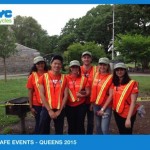
Most New Yorkers don’t have a backyard, though, especially in the more densely populated neighborhoods. Physical space is so scarce, it’s imperative to make use of the little space that is available to us. And it turns out there’s a lot of space if you just look up.

These areas can be publicly or privately owned, which often affects public accessibility. The Nature Conservancy’s New York City Program is working on putting together a cohesive data set of open space and land ownership in the city in order to assess which entities the Conservancy must work with to promote increased public access to open space.

Students should take away the basics of climate change and understand how climate impacts decision-making in their sector of interest. Enhancing their knowledge of the physical science is a must as well as understanding the importance of social science in the context of climate risk management.

What is the first thing that comes to mind when you hear the word “solar?” Sunshine, bright, warm? What places then typically come to mind to fit this description? Florida, Los Angeles, Arizona. But how about New York City?

When we think of a natural ecosystem, our minds immediately wander to tall prospering trees, clean flowing water and the plentiful flora and fauna that makes each of these ecosystems unique. But that’s not all there is to it.

How did your family or town get rid of trash when you were a kid? I imagine that most couldn’t answer this question beyond the point of, “well, we put it by the side of the road and someone just picked it up.”

By Apoorva Mathur, C+S ’15 Alessandra Giannini has been interested in the nexus of climate and society since first joining Columbia’s PhD program in Earth and Environmental Sciences. When she returned to Columbia in 2003 after completing postdoctoral research at the National Center for Atmospheric Research, she joined the International Research Institute for Climate and Society (IRI) staff as… read more










